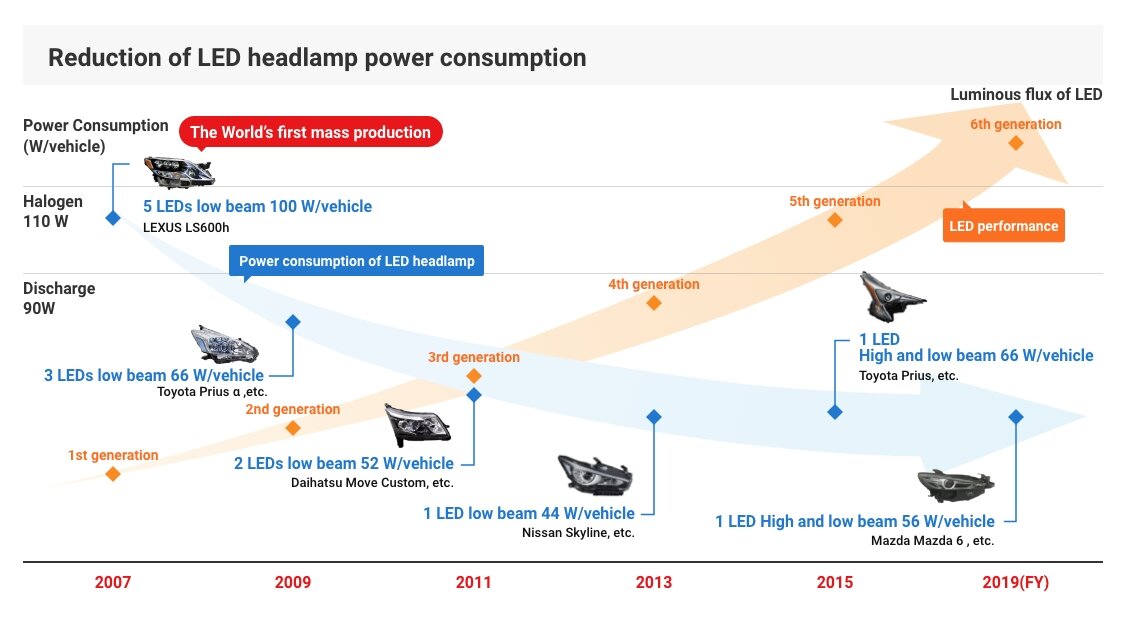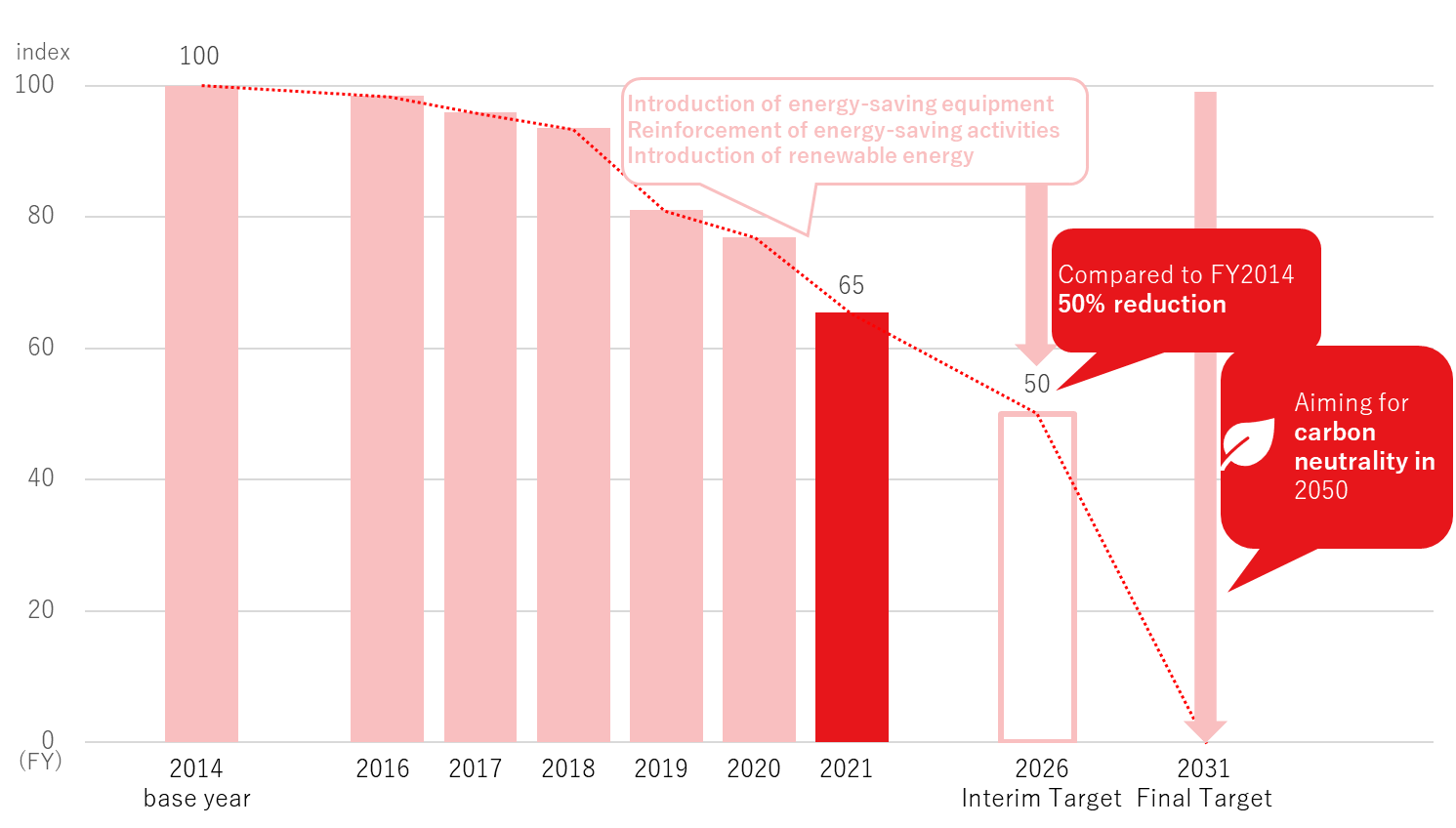Climate Change and Carbon Neutral Initiatives
Basic Approach
In order to contribute to materialize a decarbonized society, KOITO is promoting the introduction of plant buildings and energy-saving manufacturing facilities that emit less CO₂ with the goal of achieving carbon neutrality in fiscal 2051. Furthermore, we are working company-wide to reduce CO₂ emissions throughout the product life cycle, promoting products' power conservation, size reduction, and weight reduction from the development and design phase.
Efforts through Products
LED Headlamps
KOITO started using LEDs as the light source for headlamps before other companies to improve the fuel efficiency of automobiles and to reduce CO₂ emissions by reducing power consumption of the lamps. The LED headlamps consume about 40% less electricity than discharge headlamps and contribute to reduce battery load.
The adoption of LED headlamps has expanded to various vehicles, from large-size vehicles, compact vehicles, mini vehicles, and to motorcycles. In FY 2022, global LED adoption ratio among the KOITO Group's headlamps was approximately 70%, and is expected to widespread further.
We are now developing energy efficient lamps by improving the performance of the white LED lamps while reducing the size and weight.

LED Headlamp's Contribution on CO₂ Reduction
The KOITO Group is contributing to improve vehicle fuel efficiency and reduce CO₂ emissions by providing LED headlamps.
KOITO has evaluated our global environmental contribution of LED headlamps by comparing the amount of CO₂ emissions when using conventional halogen headlamps.
Contributions are increasing year by year due to the spread of LED headlamps and the evolution of light sources.
| unit | FY 2018 | FY 2019 | FY 2020 | FY 2021 | FY 2022 |
|---|---|---|---|---|---|
| Thousand t | 106.1 | 158.6 | 218.3 | 287.0 | 365.5 |
The calculation of CO₂ reduction contribution is based on EU "Technical Guidelines for the preparation of applications for the approval of innovative technologies pursuant to Regulation (EC) No 443/2009 and Regulation (EU) No 510/2011" and JAPIA "Guidelines for LCI Calculation Supplementary Provision 2 (Data Tables for Calculating Environmental Impact at Stage of Use) Version 2. The calculation of CO₂ emissions is based on a calculation method developed by our company with reference to the EU "Technical Guidelines for the preparation of the application of applications for the approval of innovative technologies pursuant to Regulation (EC) No 443/2009 and Regulation (EU) No 510/2011" and JAPIA "LCI Calculation Guidelines Supplementary Provision 2 (Data tables for calculating environmental impact during use) 2nd Edition".
Calculation method: Power-saving effect* (W)/1.000 x gasoline/electricity conversion efficiency (ℓ/kWh)/alternator efficiency x CO₂ emission coefficient of fuel (tCO₂/ℓ) x annual driving hours of car (h) x percentage of time headlamps are used x number of vehicles in our group with LED-HL
*Difference in power consumption when halogen headlamps and LED headlamps are used
LED Rear Combination Lamps
KOITO has conventionally used incandescent light bulbs to rear combination lamps. However, as LED achieves smaller, lighter, more energy efficient, and longer life lamps, and it contributes to the improvement of the fuel efficiency and CO₂ emissions reductions of vehicles, LED rear combination lamps are also being adopted in various vehicles as in the case of LED headlamps.
Development of Smaller and Lighter Components
Through our collaboration between relevant divisions, development, design, production and procurement, KOITO is working to minimize and reduce the weight of our products by reducing the number of components and resinification to contribute to improve the fuel efficiency of automobiles.
Efforts in the Production Process
To improve energy and production efficiency in the production process, KOITO is reducing CO₂ emissions by improving work methods and updating facilities, such as updating to higher-efficiency transformers and air conditioners, installing energy-efficient facilities, automatic power shutdown systems to kick in when facilities are not in use, and optimizing production lines.
We are promoting several activities with the goal of reducing CO₂ emissions by 50% from FY 2014 by fiscal 2030 and achieving carbon neutrality by FY 2051.
Factories in Japan were streamlined by integrating production lines and conducting improvement work that resulted in improved productivity and energy efficiency. With this effort, the amount of KOITO's CO₂ emissions in FY 2022 was 56.7 thousand tons, 23% decrease from FY 2014.
CO₂ emissions
| data | Unit | FY 2014 | FY 2018 | FY 2019 | FY 2020 | FY 2021 | FY 2022 | FY 2023 |
|---|---|---|---|---|---|---|---|---|
| CO₂ emissions | Thousand t-CO₂ | 73.8 | 72.7 | 70.8 | 69.0 | 59.8 | 56.7 | 48.3 |
| CO₂ intensity | tCO₂/million yen | 0.40 | 0.34 | 0.33 | 0.33 | 0.31 | 0.31 | 0.24 |
CO₂ emissions from Shizuoka, Haibara, and Sagara plants were calculated using FY 2006 CO₂ emission coefficients for electricity received from the Federation of Electric Power Companies of Japan and coefficients for city gas, LPG, and heavy kerosene based on the Energy Conservation Law and the Law Concerning the Rational Use of Energy.

Efforts in Logistics
The logistics of KOITO are mainly conducted by freight trucks. A domestic subsidiary, Koito Transport, is mainly carrying out the logistics operations.
Koito Transport acquired the Green Business Certificate in February 2004. Collaborating with KOITO, Koito Transport aims to operate environmentally friendly transport business by reducing environmental impacts focusing on reducing the energy consumption of freight trucks, CO₂ emissions, and waste emitted through the logistics process.
The amount of CO₂ emissions from the entire logistics operation of KOITO was 12,300 tons in FY 2022, and energy usage per unit* was 0.157 kl per billion yen.
* Energy usage per unit : Amount of energy (kl in crude oil equivalent) consumed in logistics per unit of sales (billion yen).
Koito Transport is gradually upgrading conventional trucks to four-axis trucks and optimizing operations by adopting long haul delivery. We are also working to improve safety by introducing studless tires. As a result of these efforts on environment and safety, Koito Transport has received a number of awards, including the Minister of the Environment's Award and the Minister of Land, Infrastructure and Transport's Award.
We will continue to pursue further eco-driving and strive to achieve safe and reliable operations and reduce CO₂ emissions.
Logistics CO₂ emissions and energy intensity
| data | unit | FY 2018 | FY 2019 | FY 2020 | FY 2021 | FY 2022 | FY 2023 |
|---|---|---|---|---|---|---|---|
| CO₂ emissions | Thousand t-CO₂ | 13.4 | 13.9 | 14.0 | 12.8 | 12.3 | 12.3 |
| Energy intensity | ㎘/100 million yen | 1.48 | 1.44 | 1.48 | 1.54 | 1.57 | 1.56 |
※Energy intensity (kℓ/100 million yen: logistics energy consumption (kℓ in crude oil equivalent) per net sales (Ore. yen))
